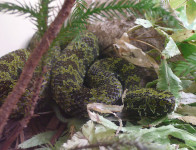
Burmese pythons are a length and a half!
- Burmese pythons are a species of lengthy snake, native to parts of south to southeast tropical and subtropical regions of Asia, and they can be found in (but not limited to) Indonesia, Myanmar, Bangladesh, Thailand, China, Nepal, Laos, Cambodia, China, and India.
- The scientific name of the Burmese python is Python bivittatus, formerly known as Python molurus bivittatus (up until 2009), and it is from the family Pythonidae, the family of pythons.
- Burmese pythons are generally between 3.7 to 5.7 metres (12 to 18.7 feet) long, and are among the lengthiest snakes in existence; and while the longest of this species was originally thought to have been 7.6 metres (25 feet) or more in length, this measurement has been disputed.
- Brown coloured patches are found over the entire length of Burmese pythons, which are surrounded by a cream to beige colour, although albino colourings exist; and they are a popular pet, in part due to the interestingly patterned appearance.
- Burmese pythons are typically found among thick undergrowth; in trees; or in water, as the python can remain up to 30 minutes underwater without air; and their diet consists primarily of small mammals, including rodents, as well as the odd reptile or bird.
A Burmese Python
Image courtesy of Rushen/Flickr
- Burmese pythons generally have a maximum weight between 90 to 137 kilograms (198 to 302 pounds), and females tend to be larger than males.
- To locate prey, a Burmese python uses its tongue to sense chemicals in its environment, while it can detect the body warmth of other animals due to its own inbuilt sensors; and it kills its prey by suffocating it by constriction and subsequently consuming it whole.
- Burmese pythons are listed as a vulnerable species, threatened by exotic pet trade; hunting for their skin and food; and a decline in habitat quality.
- Florida’s wetland Everglades, in the United States, saw the introduction of Burmese pythons around the 1980s, which have since become invasive; this being a serious issue as many native mammals they eat as prey, have had significant population decline over the past few decades.
- During a breeding season, female Burmese pythons can lay as many as 80 to 100 eggs, and the snake surrounds the eggs to incubate them at a consistent temperature, which it helps to control by its own muscle movements.
Bibliography:
Barker D, Barten S, Ehrsam J & Daddono L, The Corrected Lengths of Two Well-known Giant Pythons and the Establishment of a New Maximum Length Record for Burmese Pythons, Python Bivittatus, 2012, Vida Preciosa International, Inc., http://vpi.com/sites/default/files/Barker-et-al_CorrectPythonLengths_2.pdf
Burmese Python, 2016, National Geographic, http://animals.nationalgeographic.com.au/animals/reptiles/burmese-python/
Burmese Python, 2016, Wikipedia, https://en.wikipedia.org/wiki/Burmese_python
Padgett J, Python molurus, 2003, Animal Diversity Web, http://animaldiversity.org/accounts/Python_molurus/
Stuart B, Nguyen T, Thy N, Grismer L, Chan-Ard T, Iskandar D, Golynsky E & Lau M, Python Bivittatus, 2012, The ICUN Red List of Threatened Species, http://www.iucnredlist.org/details/193451/0









